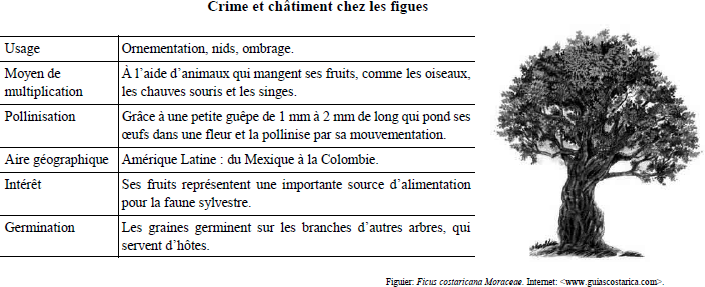
[1] Los higos y las avispas que los polinizan presentan uno de los ejemplos favoritos favoritos de los biólogos sobre
una relación beneficiosa entre dos especies diferentes. A cambio del servicio de la polinización que ofrece la
avispa, la fruta del higuerón suministra hospedaje y alimentación a las crías en desarrollo de la avispa. Sin
[4] embargo, éstas no siempre polinizan al higo. Los higuerones entonces castigan a las tramposas dejando caer las
frutas que no han sido polinizadas, matando así a las crías de las avispas que están dentro de la fruta, informan
científicos de Instituto Smithsonian de Investigaciones Tropicales (STRI, en inglés).
[7] Sus resultados, publicados en Proceedings of the Royal Society, muestran que las sanciones contra
tramposos pueden ser críticas para mantener la relación. “Las relaciones necesitan reciprocidad. Queremos saber
qué fuerzas mantienen este arreglo de 80 millones de años entre los higuerones y sus avispas polinizadoras”
[10] comentó Charlotte Jandér, la autora principal del artículo, quien llevó a cabo el estudio como becaria pre
doctoral en STRI.
“¿Qué hace que las avispas renuncien a obtener los beneficios de la relación al no pagar los costos?”
[13] Algunas especies de avispas portan polen pasivamente, el cual se les pega al cuerpo. Otras colectan el polen
activamente en bolsas especiales. Jandér evalúa la habilidad de seis diferentes pares de especies de higuerón
y avispa de higuerón para regular las trampas. Charlotte introduce, ya sea una sola avispa sin polen o una avispa
[16] que porta polen, dentro de una bolsa de redecilla que contiene un higo sin polinizar. Las avispas entran en los
higos y dejan sus huevos. Jandér encontró que los árboles con frecuencia dejan caer los higos no polinizados
antes de que las jóvenes avispas puedan madurar.
[19] “Esto se trata realmente sobre un tema muy humano de crimen y castigo. Encontramos que en las
especies que son polinizadas activamente — cuando se gasta tiempo y energía para colectar y depositar el polen
— aquéllas avispas que no proporcionaron el servicio básico de la polinización fueron sancionadas. Sin
[22] embargo, en las especies que son polinizadas de forma pasiva — cuando las avispas no tienen la necesidad de
esforzarse para polinizar — no hubo penalidades” aseguró Allen Herre, científico del cuerpo de investigadores
de STRI. “Aunque aún debemos entender claramente los costos asociados con la aplicación de las sanciones,
[25] pareciera que las mismas están presentes solo cuando se necesitan.”
“Las sanciones parecen ser una fuerza necesaria para mantener en regla esta, y otras relaciones de
mutuo beneficio. En nuestro estudio, vimos menos trampas cuando las sanciones eran más fuertes”, agrega
[28] Jandér. Los mismos resultados se han encontrado tanto para las asociaciones entre los seres humanos que entre
los insectos sociales. Es muy atractivo el pensar que los mismos principios generales pueden ayudar a mantener
la cooperación tanto dentro como entre especies.
Internet: (con adaptaciones).
A partir del texto precedente, juzgue lo ítem.
La palabra “qué” (l.9) lleva acento para enfatizar la idea principal de la oración.